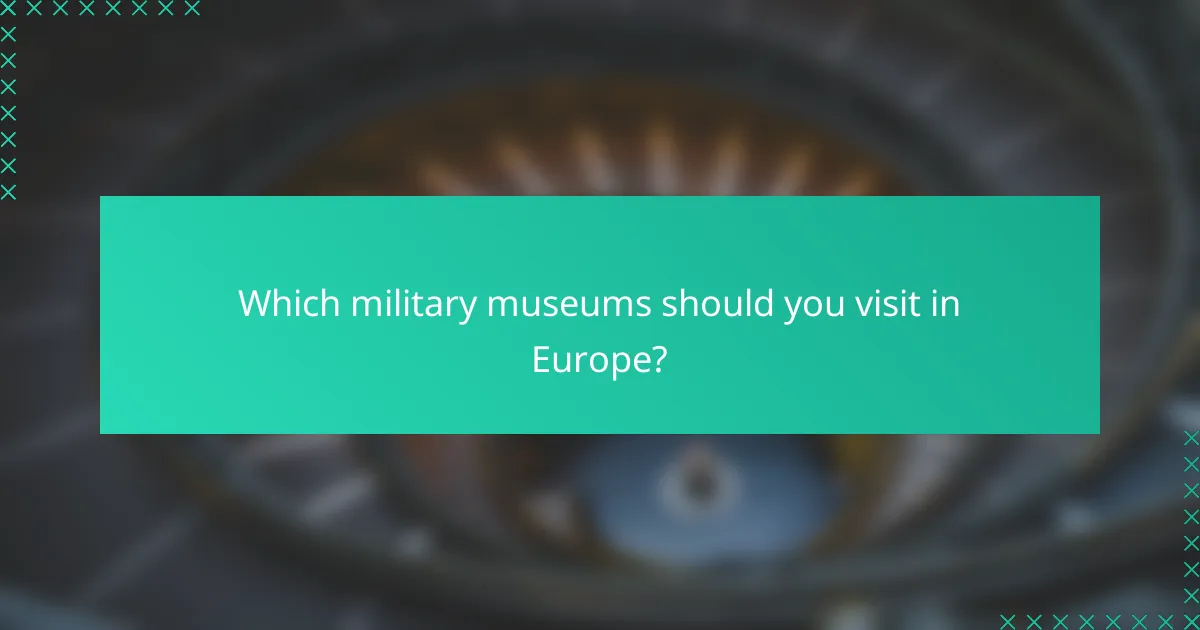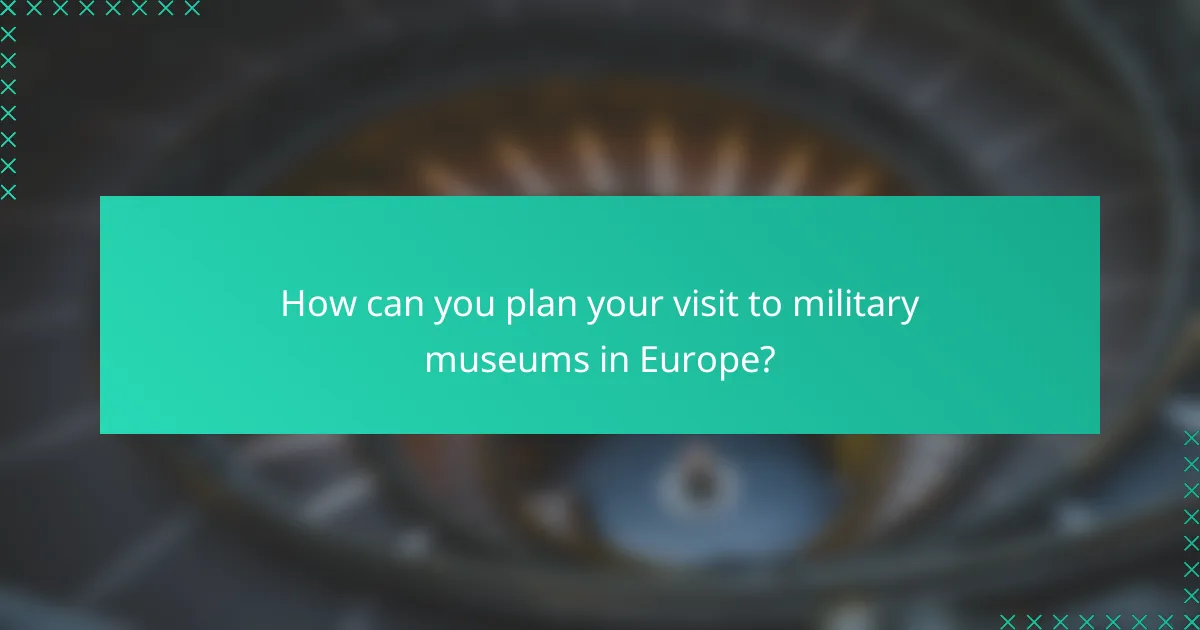Europe boasts a wealth of military museums that present captivating histories and artifacts from various conflicts. Among them, seven exceptional museums stand out for their unique collections and immersive exhibits, making them essential stops for anyone interested in military history.

Which military museums should you visit in Europe?
Europe is home to numerous military museums that showcase rich histories and artifacts from various conflicts. The following seven museums stand out for their unique collections and engaging exhibits, making them must-visit destinations for history enthusiasts.
Imperial War Museum, London
The Imperial War Museum in London offers an extensive look at the impact of war on society. Its diverse collections include personal stories, military vehicles, and artifacts from both World Wars and modern conflicts.
Visitors can explore interactive exhibits, including a recreated trench experience and a comprehensive gallery dedicated to the Holocaust. Plan to spend several hours to fully appreciate the depth of the museum’s offerings.
Musée de l’Armée, Paris
Located in the historic Hôtel des Invalides, the Musée de l’Armée is one of the largest military museums in the world. It houses an impressive collection of weapons, uniforms, and military memorabilia spanning centuries of French military history.
Don’t miss the stunning dome church, which contains the tomb of Napoleon Bonaparte. The museum frequently hosts temporary exhibitions, so check their schedule for special events during your visit.
German Tank Museum, Munster
The German Tank Museum in Munster focuses on armored vehicles and their evolution throughout military history. The museum features a vast array of tanks, from World War I to contemporary models, providing insights into their design and function.
Guided tours are available, offering detailed explanations of the exhibits. The museum is also known for its educational programs, making it a great destination for families and school groups.
National WWII Museum, New Orleans
While not in Europe, the National WWII Museum is a significant military museum worth mentioning for its comprehensive portrayal of World War II. The museum features immersive exhibits, personal stories, and artifacts that bring the history of the war to life.
Visitors can explore the D-Day exhibit and watch a 4D film that enhances the experience. If you find yourself in the U.S., this museum is a must-see for anyone interested in military history.
War Museum, Oslo
The War Museum in Oslo offers a unique perspective on Norway’s military history, including its role during World War II. The museum showcases a variety of exhibits, including military equipment, uniforms, and personal stories from veterans.
One highlight is the impressive collection of aircraft and naval vessels on display. The museum is easily accessible and provides a thoughtful look at Norway’s wartime experiences.
Military Museum of Finland, Helsinki
The Military Museum of Finland in Helsinki presents the country’s military history from the medieval period to the present day. The museum features a wide range of exhibits, including weapons, uniforms, and historical documents.
Special exhibitions often focus on specific conflicts or themes, providing deeper insights into Finland’s military engagements. The museum’s location in the heart of Helsinki makes it a convenient stop for tourists.
Royal Museum of the Armed Forces, Brussels
The Royal Museum of the Armed Forces in Brussels is renowned for its extensive collection of military artifacts and aircraft. The museum covers the history of the Belgian armed forces and includes exhibits on both World Wars.
Visitors can explore the impressive aircraft hall, which features a variety of planes and helicopters. The museum also offers educational programs and guided tours to enhance the visitor experience.

What unique exhibits can you find at these military museums?
Military museums across Europe offer a range of unique exhibits that highlight significant historical events and artifacts. Visitors can explore collections that include everything from personal items of soldiers to large military vehicles, providing a comprehensive view of military history.
World War I artifacts at Imperial War Museum
The Imperial War Museum in London features an extensive collection of World War I artifacts that illustrate the experiences of soldiers and civilians during the conflict. Key exhibits include uniforms, weapons, and personal letters that provide insight into the lives affected by the war.
One notable display is the trench experience, which recreates the conditions soldiers faced on the front lines. This immersive exhibit helps visitors understand the harsh realities of warfare during this period.
Napoleonic displays at Musée de l’Armée
Located in Paris, the Musée de l’Armée houses a significant collection of Napoleonic displays, showcasing the military campaigns and innovations of the era. Artifacts include uniforms, weapons, and even Napoleon’s personal items, which highlight his impact on European military history.
The museum’s extensive galleries allow visitors to explore the evolution of military tactics and technology during the Napoleonic Wars, offering a detailed perspective on this transformative period.
Tank collections at German Tank Museum
The German Tank Museum, or Deutsches Panzermuseum, features a comprehensive collection of tanks from various eras, focusing on their development and role in warfare. Visitors can see tanks from World War I to modern times, providing a clear view of technological advancements.
Noteworthy exhibits include interactive displays that allow visitors to learn about tank mechanics and their operational history. This museum is a must-visit for enthusiasts interested in armored warfare and military engineering.

What are the visitor experiences like at these museums?
Visitor experiences at military museums in Europe vary widely, offering engaging and educational opportunities. Many museums feature interactive displays, guided tours, and advanced technologies like virtual reality to enhance understanding of military history.
Interactive displays at National WWII Museum
The National WWII Museum in New Orleans is renowned for its immersive interactive displays. Visitors can engage with exhibits that include personal stories, artifacts, and multimedia presentations, making the history of World War II come alive.
One popular feature is the “Road to Berlin” exhibit, where guests can experience the journey of soldiers through various interactive stations. This hands-on approach allows for a deeper emotional connection to the events and people involved in the war.
Guided tours at War Museum, Oslo
The War Museum in Oslo offers guided tours that provide in-depth insights into Norway’s military history. Knowledgeable guides lead visitors through the museum’s extensive collections, sharing stories and context that enrich the experience.
These tours typically last around one to two hours and cover key exhibits, including artifacts from both World Wars and the Cold War. Booking in advance is recommended, especially during peak tourist seasons, to ensure availability.
Virtual reality experiences at Military Museum of Finland
The Military Museum of Finland incorporates virtual reality experiences that transport visitors to historical battlefields. These VR simulations allow guests to engage with significant events in Finnish military history, providing a unique perspective on the challenges faced by soldiers.
Visitors can expect to spend about 30 minutes in the VR section, which is designed for both educational and entertainment purposes. Reservations may be required, so checking the museum’s website before visiting is advisable to secure a spot.

How can you plan your visit to military museums in Europe?
Planning your visit to military museums in Europe involves considering the best times to go, how to purchase tickets, and understanding accessibility options. Each of these factors can enhance your experience and ensure a smooth visit.
Best times to visit
The best times to visit military museums in Europe are typically during the spring and fall months, when the weather is mild and crowds are smaller. Summer can be busy, especially in popular tourist destinations, while winter may limit access to some outdoor exhibits.
Consider visiting during weekdays rather than weekends to avoid larger crowds. Special events or exhibitions may also affect attendance, so check the museum’s calendar for any notable happenings.
Ticket purchasing options
Most military museums in Europe offer several ticket purchasing options, including online sales, on-site purchases, and sometimes discounted rates for groups or students. Buying tickets online in advance can save time and ensure entry, especially for popular museums.
Some museums may offer free admission on specific days or reduced rates for children and seniors. Always check the museum’s website for the latest pricing and any available promotions.
Accessibility information
Accessibility at military museums varies, but many are equipped to accommodate visitors with disabilities. Look for information on wheelchair access, accessible restrooms, and guided tours designed for those with mobility challenges.
Before your visit, it’s advisable to contact the museum directly to confirm specific accessibility features and any assistance they may provide. This ensures a more comfortable experience for all visitors.

What are the historical contexts of these military museums?
Military museums in Europe often reflect the complex historical contexts of warfare, conflict, and peace throughout the continent’s history. They serve as educational resources, showcasing artifacts and narratives that highlight the impact of military events on society and culture.
Impact of World Wars on European history
The two World Wars significantly shaped modern European history, influencing national borders, political systems, and societal structures. Museums often display memorabilia, uniforms, and weaponry from these conflicts, providing insights into the human experiences and sacrifices involved.
For instance, the impact of World War I led to the dissolution of empires and the creation of new nations, while World War II resulted in widespread destruction and the establishment of international organizations aimed at preventing future conflicts. These themes are commonly explored in military museums across Europe.
Significance of military technology evolution
The evolution of military technology has played a crucial role in shaping warfare and defense strategies. Museums often highlight advancements in weaponry, communication, and logistics, illustrating how these innovations have transformed military operations over time.
For example, the transition from traditional infantry tactics to mechanized warfare during the World Wars marked a significant shift in military strategy. Exhibits may include tanks, aircraft, and naval vessels, showcasing the technological arms race that defined the 20th century.


